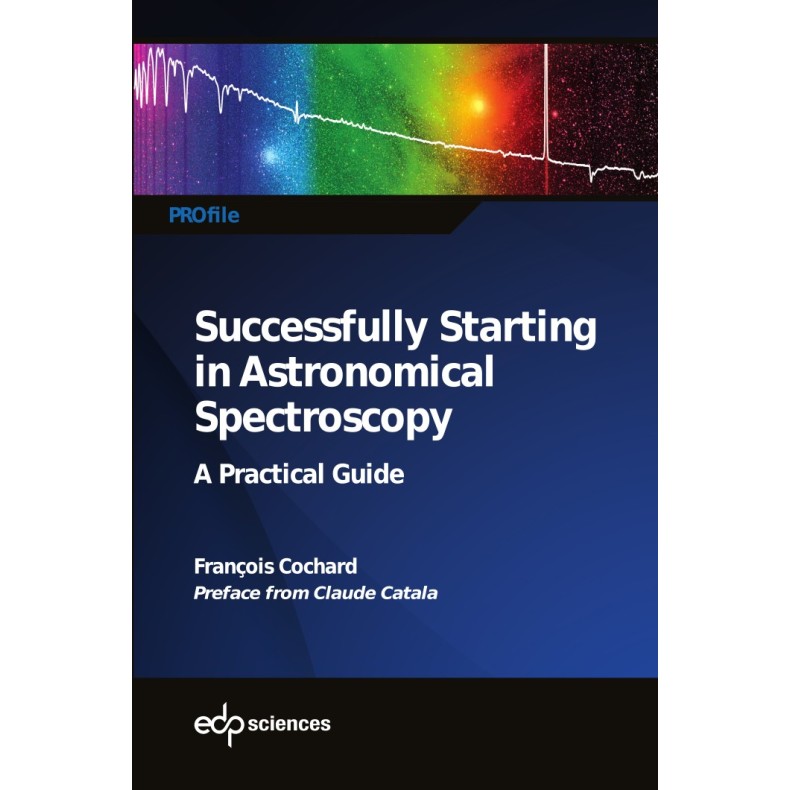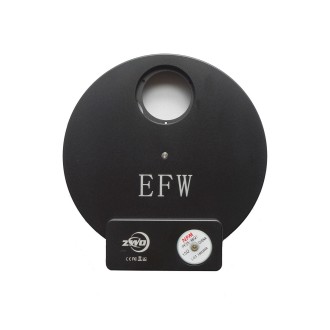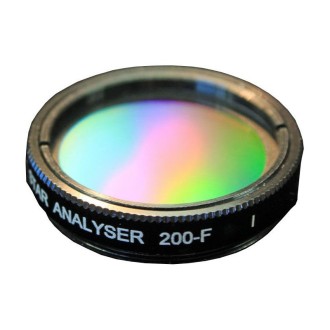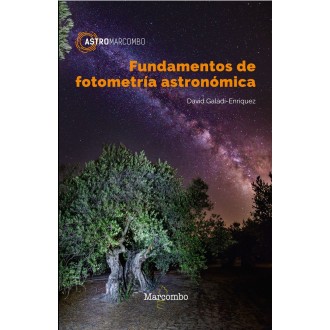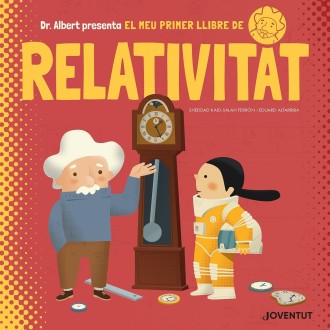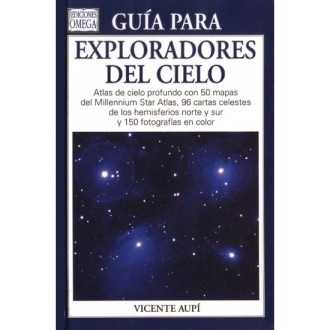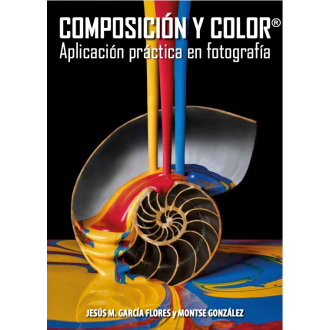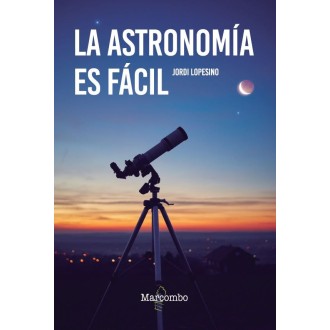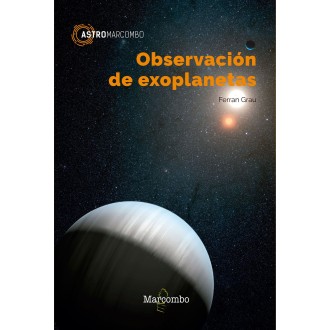Deliver it 7/17 days

Succesfully Starting in Astronomical Spectroscopy
The first practical manual to get you started in astronomical spectroscopy. The author, François Cochard, is one of the leading experts in spectroscopy in Europe and with this book he puts "light" so that all amateur astronomers can also get started successfully in the field of spectroscopy.
| Carrier | Description | Estimated Delivery | ||
|---|---|---|---|---|
 |
Home delivery - International | Home delivery - International |
Friday, 25 April - Monday, 5 May |
|

Home delivery - International
Home delivery - International
Estimated delivery:
Friday, 25 April - Monday, 5 May
Succesfully Starting in Astronomical Spectroscopy - A Practical Guide.
Practical manual for a successful introduction to astronomical spectroscopy.
This book has been written by the French author, François Cochard. In addition to being one of Europe's leading experts in this field of observation, he is also the founder of the company Shelyak Instruments which stands out for having a wide and varied range of spectroscopes for different types of observation (telescopic, solar, etc.).
The book presented here for Spain is currently only published in English or in French (Practical guide to (well) perform in astronomical spectroscopy). If instead of wanting the book in English you would like to buy it in French, please let us know and we will get you a copy in French.
Practical manual for initiation to astronomical spectroscopy:
Have you decided to take a leap into astronomical spectroscopy or are you considering it? If you want to know how to get started, go deeper or simply increase your knowledge and improve your results, then this book is for you!
Interest in amateur astronomical spectroscopy is booming. More and more amateur astronomers are diving into this exciting adventure. Obtaining the spectrum of a star is nowadays something easy to achieve with modest equipment (as long as you have the method and go step by step). This book is a guide, and it is fully designed to be of very practical use. In the content, it quickly addresses all the critical points needed to quickly help you get a quality spectrum with a slit spectroscope. It talks about astrophysics and optics, but it is not an optics or astrophysics course. No prerequisites or prior theoretical knowledge is necessary either.
A large part of the book is devoted to how to set up all your equipment and get the spectrum in the field. This is the critical point where beginners face many problems: one needs to make all the devices work together at once (telescope, spectroscope, camera ....). Little by little you will learn how to get your first spectrum, make a data reduction and look at your spectrum with more and more expectations until without realizing it you will be doing real science!
Excerpt from the preface written by Claude Catala, President of the Paris Observatory:
"The book you are about to read is remarkable in the sense that it makes the fundamentals of astronomical spectroscopy accessible to the general public and provides practical advice for its application. It will undoubtedly provoke your desire to embark on this great adventure, while providing you with the key points to achieve it."
TABLE OF CONTENTSDescription in English so as not to detract from the original content
Introduction
Chapter 1 - Entering the Realm of Amateur AstronomicalSpectroscopy
1.1 Spectrography, Spectrometry, Spectroscopy
1.2 What Does a Spectrum Look Like ?
1.3 The Missing Link
1.4 Short History
1.5 Amateur Spectroscopy Today
1.6 Starting Spectroscopy
Chapter 2 - Light
2.1 Light is a Wave
2.2 Light is a Particle
2.3 Making Light
2.4 Shifting to Spectrum
2.5 What a Human Eye Sees
2.6 Atoms and Molecules
Chapter 3 - What Light Tells us about Stars
3.1 The Light of an Ordinary Star
3.2 Each star has its Own Spectrum
3.3 Observing at Di#erent Resolutions
3.4 Limiting Magnitude
3.5 A Moving Sky
3.6 Time Evolution
3.7 Not only Stars
3.8 Basic Chemistry
Chapter 4 - What can I Observe with my Instrument ?
4.1 The Basic Questions
4.2 Many Types of Observations
4.3 What Physical Phenomena to Observe ?
4.4 Start with Low Resolution
4.5 Start with Di#erent Spectral Types
4.6 Organize your Observation
Chapter 5 - Optical Principles of a Spectroscope
5.1 Reflection, Refraction and Diffraction
5.2 Prism and Grating
5.3 Refresh of Geometric Optics
5.4 Refracting and Re#ecting Telescopes
5.5 Architecture of a Spectroscope
5.6 A Real Example: Alpy 600
5.7 Another Example: Lhires III
5.8 Guiding Stage
5.9 Calibration Light
5.10 Échelle Spectroscopes
5.11 Fibre Optic
Chapter 6 - Main Parameters of a Spectroscope
6.1 Resolution and Resolving Power
6.2 Focal ratio (F-ratio)
6.3 Magni#cation and Sampling
6.4 Resolution and Dispersion
6.5 Spectral Range
6.6 Spectral Domain
6.7 E#ciency
6.8 Mechanical Backfocus and Fastening
6.9 Telescope and Sky Quality
6.10 Adjusting the Con#guration
6.11 Keep it Simple !
Chapter 7 - CCD Cameras and Acquisition Softwares
7.1 A Wide Variety of Choices
7.2 Image Detector or Light Detector ?
7.3 Acquisition Software
7.4 Some Simple Manipulations
Chapter 8 - Adjusting the Spectroscope
8.1 Which Light Source ?
8.2 Install the Acquisition Camera
8.3 Focusing and Orientation
8.4 Blue on Left, the Red on the Right
8.5 Choice of the Range of Wavelength
8.6 Setting up the Guiding Camera
Chapter 9 - Physical Measurements and Data Reduction
9.1 Your mission: the Spectral Profile
9.2 Do not put the Cart before the Horse
9.3 Intensity and Wavelength
9.4 Distinguishing Technicalities and Science
9.5 Systematic and Random Errors
9.6 Signal-to-Noise Ratio
9.7 The Steps to Reduce the Data
9.8 Catalogues of Reference Stars
9.9 An observation is a Set of Images
Chapter 10 - First Spectroscopic Observation: The Sun
10.1 Reference Images
10.2 Data Reduction
10.3 Wavelength Calibration
10.4 Correction for the Instrumental Response
Chapter 11 - Mastering the Telescope
11.1 Mastering the Mount
11.2 Calculation of the Image Field
11.3 Understand the Telescope Motion
11.4 Pointing at a Star
11.5 Autoguiding
Chapter 12 - Installing the Spectroscope on the Telescope
12.1 Stiff Mechanical Match
12.2 Orientation of the Spectroscope
12.3 Balancing and Cable Management
12.4 Plugging in
12.5 Focus Guiding and Telescope
12.6 Last Checks
12.7 At the Beginning of the Night
Chapter 13 - Spectroscopic Observation of another
13.1 Starting the Observation
13.2 The Reference Star
13.3 Point to the Target Star
13.4 Take all the Reference Images
13.5 Data Reduction
13.6 Going Beyond
Chapter 14 - Quality of the Spectrum
14.1 Read the Outcome of the Calculation
14.2 Compare with other Observers
14.3 Verify the Wavelength Calibration
14.4 Non-uniform Intensities in the Observations
14.5 Measure of the SNR
14.6 Level of the Signal for your Instrument
Chapter 15 - Ready for the Adventure
15.1 The Typical Observing Session
15.2 Improve your Observations
15.3 Improve the Quality of the Data
15.4 Improve your Productivity
15.5 Share your Results
15.6 Spectra of Professional Quality
General characteristics:
ISBN : 9782759820269
Number of pages: 255
Publisher: EDP Sciences - PROfile

